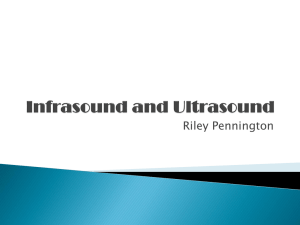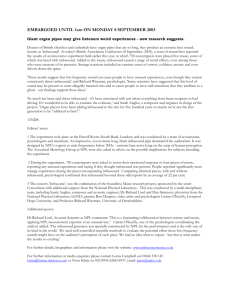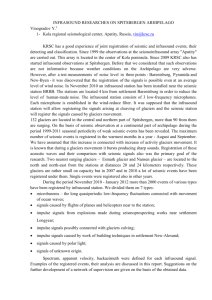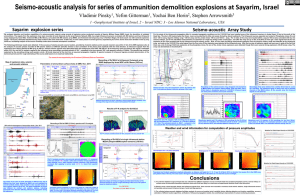7-01 Helmericks Talmadge
advertisement
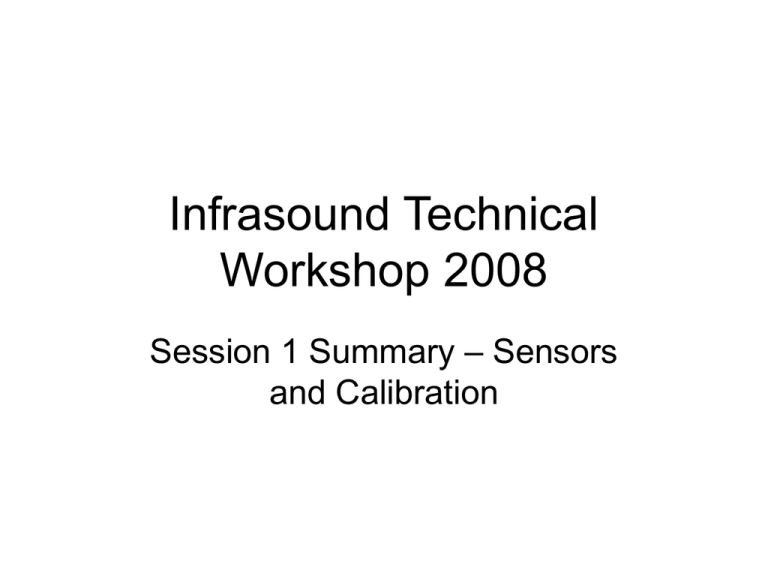
Infrasound Technical Workshop 2008 Session 1 Summary – Sensors and Calibration Chaparral Research • Linearity testing of Chaparral sensor as the signal level increases to large levels. Results show how the diaphragm distorts with large signals – Use the same sensor technology for characterizing the source signal as well as signal detection at remote locations simplifies analysis of the effects of atmospheric propagation. – Signals over 20 Pa p-p will need correction if small scale structure is important • Measured frequency response of soaker hose – Showed that foam has a flat frequency response but doesn’t have an effect on wind noise • New low cost sensor 30-40% less then M25 NCPA Infrasound Sensor • Developing a ruggedized, low cost sensor with similar characteristics to existing sensors used in the IMS arrays – Intended for use in temporary deployments in hostile environments – Augment existing arrays to improve understanding of local / regional sound sources (clutter reduction) • Uses piezoceramic sensing elements – Good calibration aging, insensitive to rough handling – No change with altitude – More vibrationaly sensitive then diaphragm DASE MB2007 • Miniaturization of the MB2005 sensing technology – Base sensor is passive. Various amplifiers can be used to optimize for power or noise/response – Much smaller form factor with reduced weight – No adjustment necessary with altitude changes – Currently working on prototypes MilTEC Distributed Array Gave an update on their distributed array, including their recent studies with a 96-element “wagon wheel” configuration, co-located on one of the elements of the Piñon Flat Observatory, which was attached to a wind-screen filter. Sensor use a piezoceramic sensing element, no active components in current design Similar performance to the Piñon Flat element were achieved by using a “straight” average over the 96-element arrays. Because each of the 96 elements were simultaneously digitized, time-shifted averages that have less effect on the measured frequency of infrasound signals could also be achieved for signals of interest. How this would be utilized in an IMS station without the long-term storage of all 96-channels has yet to be explored. Finally, more sophisticated averaging techniques holds the promise of achieving superior rejection of wind-noise over mechanical filters. PTS Portable Array Gave a report on the status of the PTS portable array, which is near the completion of the testing phase, and will be deployed soon near an active volcano in Chile. Portable infrasound arrays can be used to: •Augment existing IMS stations to improve the understanding of regional sources of infrasound (“reduce signal clutter”). • Participate in “ground truth” experiments involving the controlled demolitions of explosives as well as placement near known infrasound sources such as active volcanoes. • Evaluate site locations for proposed new infrasound arrays by measuring the local/regional infrasound sources at proposed site locations. The planned deployment of the PTS array is expected to aid in the position of the future I40PG infrasound station. Development of a Portable, Controlled Infrasound Source One challenge in the performance evaluation of an infrasound array is the prior absence of controlled infrasound sources which were sufficiently powerful enough to be detected by all elements of an array. The University of Hawaii portable sound source is aimed to address this problem, by utilizing a rotary subwoofer to produce infrasound as low as 5 Hz. The current design of this system involved the installation of the sound source in the back of a box truck. Detections by infrasound sensors were obtained with this system for distances as far away as 5 km. This source would allow “in situ” calibration of a complete IMS array, including the frequency-response of the wind-screen filters for the microphones, something that is currently difficult to achieve by other means. UCSD M-Sequence Infrasound Calibrator An alternative solution is being studied by the UCSD group. This involves an array of eight subwoofers + associated power amplifier(s) that allowed the generation of signals as low in frequency as 8 Hz. This approach gives a linear sound source, which means that signal generation/detection schemes such as M-sequences can be efficiently used. The UCSD group studied the use of M-sequence phase-modulated signals. These have the advantage of producing a controlled broadband signal. Because different M-sequences are orthogonal to each other, multiple sources can in principle be used simultaneously to characterize the performance of an array or array element from different directions of arrival. The main limitation of this approach is the the lowest frequency achieved is only 8-Hz (compared to 5-Hz for the Hawaii speaker), and the maximum detectable range was only 240m; sufficient for singlesensor characterizations, but not for full arrays simultaneously. End Overview Summary • Continued Infrasound Sensor Development – Reduced cost, power, weight, size – Improved characterization of existing sensors • Various sensing technologies – Piezoelectric, diaphragm, bellows, optical • Development and use of infrasound sources – Conventional speakers – Rotory speaker – Use of signals and processing techniques to improve the usefulness of these sources with low S/R Overview Summary • Advantages of distributed arrays (sensor carpet) – Able to reduce wind noise as much as a conventional hose/pipe array but without resonances, and an ability to still work with higher frequencies • PTS portable array – Development of portable array packages – Many applications
